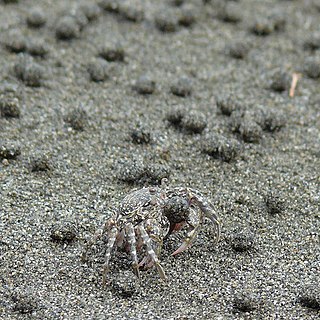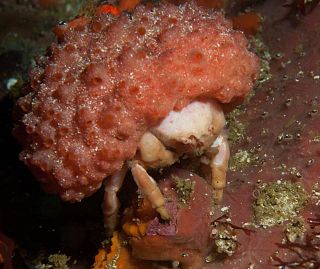
The Decapoda or decapods are an order of crustaceans within the class Malacostraca, and includes crabs, lobsters, crayfish, shrimp, and prawns. Most decapods are scavengers. The order is estimated to contain nearly 15,000 extant species in around 2,700 genera, with around 3,300 fossil species. Nearly half of these species are crabs, with the shrimp and Anomura including hermit crabs, porcelain crabs, squat lobsters making up the bulk of the remainder. The earliest fossils of the group date to the Devonian.

Xanthidae is a family of crabs known as gorilla crabs, mud crabs, pebble crabs or rubble crabs. Xanthid crabs are often brightly coloured and are highly poisonous, containing toxins which are not destroyed by cooking and for which no antidote is known. The toxins are similar to the tetrodotoxin and saxitoxin produced by puffer fish, and may be produced by bacteria in the genus Vibrio living in symbiosis with the crabs, mostly V. alginolyticus and V. parahaemolyticus.

Pinnotheres is a genus of crabs, including the pea crab. Many species formerly in Pinnotheres have been placed in new genera, such as Zaops ostreus, the oyster crab and Nepinnotheres novaezelandiae, the New Zealand pea crab. The species currently recognised in the genus Pinnotheres are:

Portunidae is a family of crabs which contains the swimming crabs. Its members include many well-known shoreline crabs, such as the blue crab and velvet crab. Two genera in the family are contrastingly named Scylla and Charybdis; the former contains the economically important species black crab and Scylla paramamosain.

Sand bubbler crabs are crabs of the genera Scopimera and Dotilla in the family Dotillidae. They are small crabs that live on sandy beaches in the tropical Indo-Pacific. They feed by filtering sand through their mouthparts, leaving behind balls of sand that are broken up by the incoming high tide.

Macrophthalmus is a genus of crabs which are widespread across the Indo-Pacific. It contains the following species : Species in this genus are often referred to as sentinel crabs.

Menippidae is a family of crabs of the order Decapoda.

The Varunidae are a family of thoracotrematan crabs. The delimitation of this family, part of the taxonomically confusing Grapsoidea, is undergoing revision. For a long time, they were placed at the rank of subfamily in the Grapsidae, but they appear to be closest to Macropthalmus and the Mictyridae, which are usually placed in the Ocypodoidea. It may thus be better to merge the latter superfamily with the Grapsoidea, retaining the latter name as it is older.

Hexapodidae is a family of crabs, the only family in the superfamily Hexapodoidea. It has traditionally been treated as a subfamily of the family Goneplacidae, and was originally described as a subfamily of Pinnotheridae. Its members can be distinguished from all other true crabs by the reduction of the thorax, such that only seven sternites are exposed, and only four pairs of pereiopods are present. Not counting the enlarged pair of claws, this leaves only six walking legs, from which the type genus Hexapus, and therefore the whole family, takes its name. Some anomuran "crabs", such as porcelain crabs and king crabs also have only four visible pairs of legs. With the exception of Stevea williamsi, from Mexico, all the extant members are found either in the Indo-Pacific oceans, or around the coast of Africa.

Pilumnoidea is a superfamily of crabs, whose members were previously included in the Xanthoidea. The three families are unified by the free articulation of all the segments of the male crab's abdomen and by the form of the gonopods. The earliest fossils assigned to this group are of Eocene age.

Actumnus is a genus of crabs in the family Pilumnidae. Alongside the 28 extant species, it has a fossil record extending back into the Miocene.

Leucosiidae is a family of crabs containing three subfamilies and a number of genera incertae sedis:

The family Homolidae, known as carrier crabs or porter crabs, contains 14 genera of marine crabs. They mostly live on the continental slope and continental shelf, and are rarely encountered. Members of the Homolidae have their fifth pereiopods in a sub-dorsal position, which allows them to hold objects in place over the rear half of the carapace. The objects carried include sponges, black corals and gorgonians, and this behaviour may be a defence mechanism against predators. Some species have been observed carrying living sea urchins in a symbiotic relationship which allows them to benefit from the protection of the urchin's dangerous spikes.

Actaea is a genus of crabs in the family Xanthidae, containing the following species:

Paraxanthias is a genus of crabs in the family Xanthidae, containing one exclusively fossil species and the following extant species:

Pilumnus is a genus of crabs, containing the following species:

Pseudodromia is a genus of crabs in the family Dromiidae, often referred to as sponge crabs. They are small or medium-sized crabs which get their name from the ability to shape a living sponge into a portable shelter for themselves. A sponge crab cuts out a fragment from a sponge and trims it to its own shape using its claws. The last two pairs of legs are shorter than other legs and bend upward over the crab's carapace, to hold the sponge in place. The sponge grows along with the crab, providing a consistent shelter.

Dynomenidae is a family of crabs in the superfamily Dromioidea mostly found in Madagascar. There are nineteen genera in this family: five extant and fourteen known from fossils:

Lamarckdromia is a genus of crabs within the family Dromiidae, containing 3 species. The most recent species described, Lamarckdromia beagle, was discovered in Australia after being washed onto a beach in 2022. Its species name beagle is in recognition of Charles Darwin’s ship HMS Beagle.


















